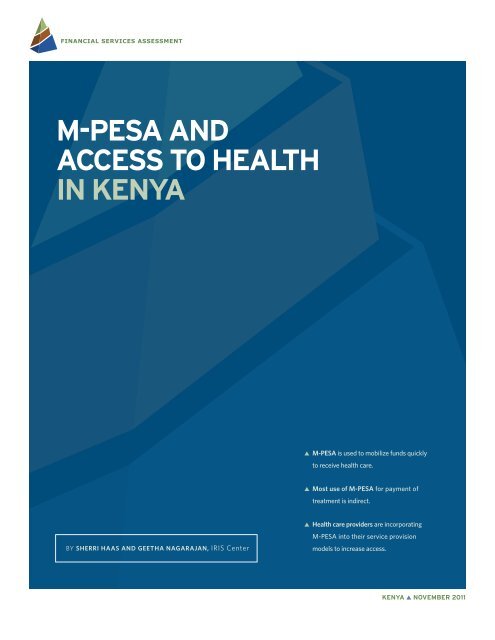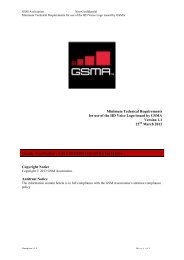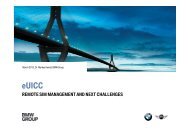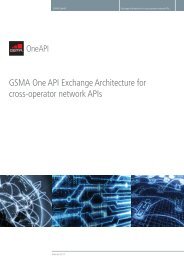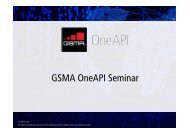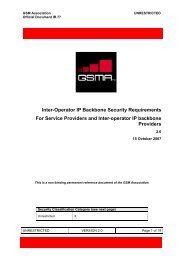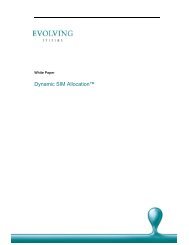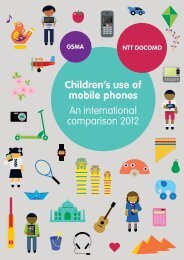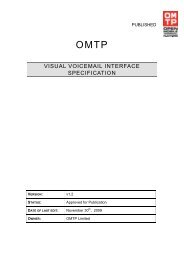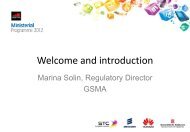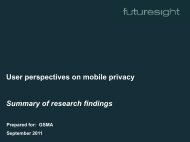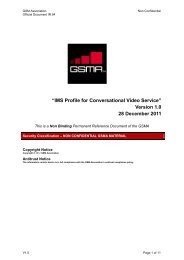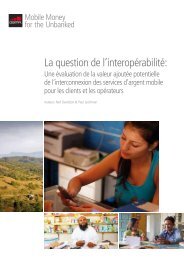m-Pesa and access to health in Kenya - Financial Services ...
m-Pesa and access to health in Kenya - Financial Services ...
m-Pesa and access to health in Kenya - Financial Services ...
Create successful ePaper yourself
Turn your PDF publications into a flip-book with our unique Google optimized e-Paper software.
F<strong>in</strong>ancial <strong>Services</strong> Assessment<br />
M-<strong>Pesa</strong> <strong>and</strong><br />
<strong>access</strong> <strong>to</strong> <strong>health</strong><br />
<strong>in</strong> <strong>Kenya</strong><br />
s M-PESA is used <strong>to</strong> mobilize funds quickly<br />
<strong>to</strong> receive <strong>health</strong> care.<br />
s Most use of M-PESA for payment of<br />
treatment is <strong>in</strong>direct.<br />
By Sherri Haas <strong>and</strong> Geetha Nagarajan, IRIS Center<br />
s Health care providers are <strong>in</strong>corporat<strong>in</strong>g<br />
M-PESA <strong>in</strong><strong>to</strong> their service provision<br />
models <strong>to</strong> <strong>in</strong>crease <strong>access</strong>.<br />
<strong>Kenya</strong> s November 2011
M-<strong>Pesa</strong> <strong>and</strong> <strong>access</strong> <strong>to</strong> <strong>health</strong> <strong>in</strong> kenya<br />
The most common way one hears <strong>Kenya</strong>ns refer <strong>to</strong> M-PESA <strong>in</strong> relation<br />
<strong>to</strong> <strong>health</strong> care is as “emergency money”—funds received quickly <strong>to</strong> obta<strong>in</strong><br />
immediate necessary treatment.<br />
Introduction<br />
Much is now written about M-PESA on its bus<strong>in</strong>ess model <strong>and</strong> extent<br />
of its use at the household <strong>and</strong> community levels. M-PESA is an agentassisted,<br />
mobile phone-based, person-<strong>to</strong>-person payment <strong>and</strong> money<br />
transfer system <strong>in</strong> <strong>Kenya</strong>. It allows users <strong>to</strong> s<strong>to</strong>re money on their mobile<br />
phones <strong>in</strong> an electronic account <strong>and</strong> deposit or withdraw money <strong>in</strong> the<br />
form of hard currency at one of M-PESA’s numerous agent locations.<br />
By March 2011, M-PESA reached over 13.8 million registered users<br />
(over one-third of <strong>Kenya</strong>’s population) through 27,000 M-PESA agents<br />
throughout the country. Safaricom has also built a low-cost payment<br />
platform <strong>in</strong> M-PESA which is allow<strong>in</strong>g users <strong>to</strong> meet an ever-broader<br />
array of their payment <strong>and</strong> sav<strong>in</strong>gs needs.<br />
Little <strong>in</strong>formation exists, however, on the recent <strong>in</strong>itiatives that utilize<br />
the M-PESA platform <strong>to</strong> facilitate delivery of necessary services. In<br />
particular, what is the current role of M-PESA <strong>in</strong> facilitat<strong>in</strong>g <strong>access</strong> <strong>to</strong><br />
<strong>health</strong> services <strong>in</strong> <strong>Kenya</strong> <strong>and</strong> what potential exists for the M-PESA platform<br />
<strong>to</strong> <strong>in</strong>crease <strong>access</strong> <strong>to</strong> <strong>health</strong> care?<br />
IRIS conducted a study which addressed the above issues us<strong>in</strong>g <strong>in</strong>ductive<br />
methods <strong>to</strong> gather primarily qualitative <strong>in</strong>formation <strong>and</strong> a limited amount<br />
of quantitative data. The study was conducted over two rounds between<br />
September–December of 2009 <strong>and</strong> April–June of 2010 through focus<br />
group discussions, case studies, <strong>and</strong> key <strong>in</strong>formant <strong>in</strong>terviews <strong>in</strong> Kibera <strong>in</strong><br />
Nairobi; Murang’a District <strong>in</strong> Central Prov<strong>in</strong>ce <strong>and</strong> Kitui District <strong>in</strong> Eastern<br />
Prov<strong>in</strong>ce. Study f<strong>in</strong>d<strong>in</strong>gs <strong>and</strong> additional literature related <strong>to</strong> M-PESA’s use<br />
<strong>in</strong> the acquisition of <strong>health</strong> services are discussed below.<br />
Health Care <strong>in</strong> <strong>Kenya</strong><br />
As of 2005, 45 percent of <strong>Kenya</strong>ns lived below the national poverty<br />
l<strong>in</strong>e, <strong>and</strong> <strong>in</strong> 2008, nearly 40 percent did not have <strong>access</strong> <strong>to</strong> an improved<br />
water source, leav<strong>in</strong>g them more vulnerable <strong>to</strong> disease (WB World<br />
Development Indica<strong>to</strong>rs). In 2009, per capita expenditure on <strong>health</strong><br />
was PPP US$68 of which 46% was borne by the households. A recent<br />
survey <strong>in</strong>dicated that 44% of the sick did not seek <strong>health</strong>care due <strong>to</strong><br />
high costs <strong>and</strong> 18% due <strong>to</strong> long distance <strong>to</strong> the nearest <strong>health</strong> facility<br />
(Allianz Worldwide Care). The life expectancy at birth was 60 years.<br />
Lack of adequate medical care beg<strong>in</strong>s from birth for many <strong>Kenya</strong>ns. In<br />
2009, only 44 percent of births were attended by a skilled <strong>health</strong> professional<br />
(WHO 2009). With little <strong>access</strong> <strong>to</strong> funds <strong>to</strong> afford preventative<br />
care <strong>and</strong> high <strong>in</strong>cidence of diseases, many <strong>Kenya</strong>ns f<strong>in</strong>d themselves<br />
<strong>in</strong> a situation where emergency medical care is necessary but not unaffordable<br />
with funds on h<strong>and</strong>.<br />
Health Seek<strong>in</strong>g <strong>and</strong> M-PESA—Current Practices <strong>and</strong><br />
Emerg<strong>in</strong>g Trends<br />
M-PESA is known for its fast, reliable <strong>and</strong> cost effective way <strong>to</strong> transfer<br />
payments <strong>and</strong> remittances between persons <strong>and</strong> bus<strong>in</strong>esses across the<br />
country. Potentially, therefore, M-PESA can play a crucial role <strong>in</strong> the<br />
<strong>health</strong> sec<strong>to</strong>r through two pathways: (i) <strong>to</strong> quickly mobilize funds from<br />
friends <strong>and</strong> relatives <strong>in</strong> order <strong>to</strong> seek timely <strong>health</strong> care, <strong>and</strong> (ii) <strong>to</strong> facilitate<br />
transfer of funds <strong>to</strong> meet travel costs <strong>to</strong> the hospital <strong>and</strong> <strong>to</strong> pay<br />
for the <strong>health</strong> care.<br />
Many M-PESA users <strong>in</strong> the study reported that they have used M-PESA<br />
<strong>to</strong> get money for medical procedures <strong>and</strong> <strong>to</strong> seek medical consultation on<br />
time. M-PESA was frequently cited <strong>in</strong> focus group discussions <strong>and</strong> <strong>in</strong>terviews<br />
as be<strong>in</strong>g used <strong>to</strong> obta<strong>in</strong> funds quickly <strong>in</strong> case of medical emergencies.<br />
A case study respondent <strong>in</strong> Kitui noted that she would request<br />
money if one of her children was sick, <strong>and</strong> that the “greatest advantage<br />
of M-PESA is that you can get money <strong>in</strong>stantly <strong>to</strong> solve problems”. The<br />
<strong>in</strong>creased speed of payment can have positive effects on the <strong>health</strong> of<br />
the <strong>in</strong>dividual as well as potentially reduc<strong>in</strong>g the overall costs of treatment.<br />
Faster <strong>access</strong> <strong>to</strong> care can reduce the <strong>to</strong>tal cost of treatment by<br />
prevent<strong>in</strong>g potential further deterioration of the condition. It can also<br />
decrease the amount of time the <strong>in</strong>dividual <strong>and</strong> caregivers spend away<br />
from other productive work. Microf<strong>in</strong>ance Opportunities—IRIS’ partner<br />
on the M-PESA study— found that approximately one-third of hospital<br />
bills reported by their f<strong>in</strong>ancial diaries respondents were paid for with<br />
remittances received through M-PESA (Stuart <strong>and</strong> Cohen, 2011).<br />
Timely <strong>health</strong> seek<strong>in</strong>g is considered <strong>to</strong> help strengthen hospitals <strong>and</strong> medical<br />
facilities. Immediate payment for services helps keep costs down<br />
<strong>and</strong> allows the organization <strong>to</strong> provide better-quality services. For example,<br />
hospitals may not release patients until all bills have been paid,<br />
<strong>in</strong>curr<strong>in</strong>g additional costs while wait<strong>in</strong>g for the patient <strong>to</strong> make payment.<br />
With M-PESA, it is found that the patient is able <strong>to</strong> obta<strong>in</strong> funds<br />
faster <strong>and</strong> the <strong>in</strong>creased speed of payment keeps costs lower for the<br />
hospital as well as the patient (Ng’weno, 2010).<br />
Innovative <strong>health</strong> care providers are utiliz<strong>in</strong>g the M-PESA system <strong>to</strong> <strong>in</strong>crease<br />
patient <strong>access</strong> <strong>to</strong> <strong>health</strong> care. For example, the Freedom from<br />
Fistula Foundation (FFF) found that one of the major barriers <strong>to</strong> patients<br />
receiv<strong>in</strong>g treatment or receiv<strong>in</strong>g timely care was the cost of transportation<br />
<strong>to</strong> an appropriate <strong>health</strong> services provider. Obstetric fistula is a<br />
condition caused by <strong>in</strong>ternal <strong>in</strong>juries susta<strong>in</strong>ed while giv<strong>in</strong>g birth, more<br />
often when childbirth is done outside of proper medical assistance. In<br />
2009, the foundation, which operates a fistula unit <strong>in</strong> Nairobi as well as<br />
cl<strong>in</strong>ics around the country, began an advertisement campaign <strong>to</strong> raise<br />
awareness of fistula <strong>and</strong> that it can be treated. When women call <strong>in</strong> <strong>to</strong><br />
the foundation, they are asked about their ability <strong>to</strong> travel <strong>to</strong> the closest<br />
facility. If they do not have the means available, the foundation transfers<br />
funds through M-PESA for their transportation costs. This allows<br />
more women of lower-<strong>in</strong>come <strong>to</strong> have <strong>access</strong> <strong>to</strong> appropriate medical<br />
care, as simply refund<strong>in</strong>g transportation costs on arrival would require<br />
the woman <strong>to</strong> be able <strong>to</strong> pay the travel expenses upfront. FFF does not<br />
advertise the availability of transportation fund<strong>in</strong>g; it is only through the<br />
screen<strong>in</strong>g call that they determ<strong>in</strong>e f<strong>in</strong>ancial need <strong>and</strong> then M-PESA the<br />
F<strong>in</strong>ancial <strong>Services</strong> Assessment s 2
M-<strong>Pesa</strong> <strong>and</strong> <strong>access</strong> <strong>to</strong> <strong>health</strong> <strong>in</strong> kenya<br />
<strong>in</strong>dividual the funds. In the first 16 months of the program, the FFF reported<br />
that they had not lost any of the transportation money <strong>to</strong> fraud,<br />
<strong>and</strong> that the use of M-PESA had made it possible for many women <strong>to</strong><br />
get treatment who otherwise would not have (Bangser, 2011). A similar<br />
program is also <strong>in</strong> operation <strong>in</strong> Tanzania us<strong>in</strong>g M-PESA.<br />
M-PESA is also <strong>in</strong> use as a means of sav<strong>in</strong>g <strong>to</strong>wards <strong>health</strong> care expenses.<br />
A nurse at a local cl<strong>in</strong>ic <strong>in</strong> Kitui stated that she was able <strong>to</strong> use M-PESA<br />
<strong>to</strong> pay for a surgery she had <strong>in</strong> Nairobi because she could save for it on<br />
her M-PESA account. More formally, Changamka Micro<strong>health</strong> Limited<br />
<strong>in</strong> <strong>Kenya</strong> offers multiple sav<strong>in</strong>gs plans which operate <strong>in</strong> partnership<br />
with the M-PESA payment platform. The Maternity Smartcard allows<br />
a woman <strong>to</strong> start sav<strong>in</strong>g <strong>to</strong>wards ante-natal, maternity, <strong>and</strong> post-natal<br />
care start<strong>in</strong>g with just 250 <strong>Kenya</strong> shill<strong>in</strong>gs (approximately $3.12). The<br />
price of services is predeterm<strong>in</strong>ed <strong>and</strong> known <strong>to</strong> the smartcard users,<br />
<strong>and</strong> the partnership with M-PESA allows them <strong>to</strong> add any amount of<br />
sav<strong>in</strong>gs <strong>to</strong> the card throughout the pregnancy. It is not even necessary<br />
for an <strong>in</strong>dividual <strong>to</strong> visit Changamka Micro<strong>health</strong> itself <strong>to</strong> start sav<strong>in</strong>g,<br />
as the organization has distribution po<strong>in</strong>ts at other locations <strong>in</strong>clud<strong>in</strong>g<br />
supermarkets <strong>and</strong> some bank branches.<br />
For the most part, however, the role of M-PESA <strong>in</strong> <strong>health</strong> care is not necessarily<br />
straight-forward. Interviews with <strong>health</strong>-care providers <strong>in</strong>dicated<br />
that that they did not accept M-PESA as a direct means of payment.<br />
While M-PESA users may withdraw money from their accounts (or<br />
have someone send money <strong>to</strong> their account), <strong>in</strong> most cases they must<br />
still withdraw the money <strong>in</strong> cash <strong>and</strong> then pay the <strong>health</strong> center or deposit<br />
the money <strong>in</strong><strong>to</strong> the hospital’s bank account. Therefore, while patients<br />
could have used M-PESA <strong>to</strong> obta<strong>in</strong> funds for treatment, because<br />
the payments were made <strong>in</strong> cash, it was impossible for the provider <strong>to</strong><br />
know if the money was received through M-PESA or other means. Thus,<br />
while study participants identified M-PESA as help<strong>in</strong>g manage hospital<br />
bills, the utility was not usually a direct transaction between the<br />
M-PESA user <strong>and</strong> the cl<strong>in</strong>ic. But, while many cl<strong>in</strong>ics do not take direct<br />
M-PESA payments, many doc<strong>to</strong>rs, nurses <strong>and</strong> adm<strong>in</strong>istra<strong>to</strong>rs felt that<br />
people were better able <strong>to</strong> get money quickly with M-PESA <strong>to</strong> pay for<br />
lab tests <strong>and</strong> treatments.<br />
Path Forward<br />
To date, the use of M-PESA for atta<strong>in</strong><strong>in</strong>g <strong>health</strong> services has <strong>to</strong> date<br />
been primarily <strong>in</strong>direct—users receive funds through M-PESA <strong>and</strong> cash<br />
out the money <strong>to</strong> pay for services <strong>in</strong>dependent from the providers. But,<br />
high potential exist <strong>to</strong> improve <strong>access</strong> <strong>to</strong> <strong>health</strong> care <strong>in</strong> <strong>Kenya</strong> through<br />
use of the M-PESA platform as more providers <strong>in</strong>tegrate it <strong>in</strong><strong>to</strong> their<br />
methods of service delivery.<br />
The potential is highlighted by the new developments that are aimed at<br />
enhanc<strong>in</strong>g the functions of M-PESA <strong>to</strong> provide direct bill<strong>in</strong>g services for<br />
<strong>health</strong> seekers <strong>and</strong> hospitals. Twelve <strong>in</strong>stitutions are listed as “Health<br />
Management Providers <strong>and</strong> Hospitals” for M-PESA Pay Bill accounts<br />
with Safaricom. This <strong>in</strong>cludes organizations such as Population <strong>Services</strong><br />
International, <strong>to</strong> <strong>in</strong>surance companies, <strong>to</strong> hospitals. There are also a<br />
number of organizations categorized as Insurance Agencies which<br />
could also be considered <strong>to</strong> be part of <strong>health</strong> provision (Safaricom,<br />
2011).<br />
A possible improvement <strong>to</strong> <strong>health</strong> services could also be achieved<br />
through sav<strong>in</strong>gs products that couple with M-PESA <strong>in</strong> a way that allows<br />
users <strong>to</strong> deposit small amounts of funds <strong>to</strong> smart cards with specific<br />
purposes, such as medical needs, with a pric<strong>in</strong>g structure that allows<br />
the user <strong>to</strong> deposit small payments frequently without high per-deposit<br />
fees. The Changamka Medical Smart Card is one such product. Another<br />
possibility would be an option which allows an M-PESA user <strong>to</strong> set<br />
aside a certa<strong>in</strong> percentage or value of <strong>in</strong>com<strong>in</strong>g funds <strong>in</strong> a sav<strong>in</strong>gs account.<br />
It is not uncommon <strong>to</strong> hear that M-PESA is only useful <strong>to</strong> people who<br />
receive remittances. Low-cost sav<strong>in</strong>gs products, such as <strong>health</strong> sav<strong>in</strong>gs<br />
cards, are one way <strong>in</strong> which the M-PESA platform could br<strong>in</strong>g benefit <strong>to</strong><br />
low-<strong>in</strong>come <strong>Kenya</strong>ns whether or not they receive any remittances.<br />
REFERENCES:<br />
Allianz World, 2009, http://www.allianzworldwidecare.com/<strong>health</strong>care-<strong>in</strong>kenya<br />
Africa Health Workforce Observa<strong>to</strong>ry, Human Resources for Health<br />
Country Profile: <strong>Kenya</strong>, 2009, http://www.hrh-observa<strong>to</strong>ry.afro.who.<strong>in</strong>t/<br />
images/Document_Centre/kenya_country_profile.pdf<br />
2008-2009 <strong>Kenya</strong> Demographic <strong>and</strong> Health Survey Fact Sheet. http://<br />
www.measuredhs.com/pubs/pdf/GF17/GF17.pdf<br />
Bangser, Maggie. Mak<strong>in</strong>g Mobile Phones Work for Women with Fistula: The<br />
M-PESA Experience <strong>in</strong> <strong>Kenya</strong> <strong>and</strong> Tanzania. Fistula Care at EngenderHealth.<br />
2011<br />
Changamka Micro<strong>health</strong>. http://changamka.co.ke/html/aboutus.html 2011.<br />
<strong>Kenya</strong> Bankers Sacco Society Ltd. M-PESA. http://www.kbsacco.co.ke/<br />
m-pesa.html Accessed: June 2011.<br />
M-PESA Bill Pay Partners. Safaricom. Accessed June, 2011. http://<br />
www.safaricom.co.ke/fileadm<strong>in</strong>/M-PESA/Documents/Utility_<br />
Organizations_11thMay2011.pdf<br />
Ng’weno, Amolo. How Mobile Money Has Changed Lives <strong>in</strong> <strong>Kenya</strong>. Global<br />
Sav<strong>in</strong>gs Forum. Bill & Mel<strong>in</strong>da Gates Foundation. November 2010.<br />
Plyler, Megan G., Sherri Haas <strong>and</strong> Geetha Nagarajan. Community-Level<br />
Economic Effects of M-PESA <strong>in</strong> <strong>Kenya</strong>: Initial F<strong>in</strong>d<strong>in</strong>gs. The IRIS Center,<br />
University of Maryl<strong>and</strong>, College Park, June 2010. http://fsassessment.umd.<br />
edu/publications.html<br />
Stuart, Guy <strong>and</strong> Monique Cohen. Cash In, Cash Out <strong>Kenya</strong>: The Role of<br />
M-PESA <strong>in</strong> the Lives of Low-Income People. Microf<strong>in</strong>ance Opportunities.<br />
September 2011.<br />
World Health Organization. Country Statistics – <strong>Kenya</strong>. 2009. http://apps.<br />
who.<strong>in</strong>t/ghodata/?vid=11500&theme=country<br />
World Bank World Development Indica<strong>to</strong>rs. <strong>Kenya</strong> Country Data. http://<br />
data.worldbank.org/country/kenya.<br />
F<strong>in</strong>ancial <strong>Services</strong> Assessment s 3
This study is part of the F<strong>in</strong>ancial<br />
<strong>Services</strong> Assessment project, undertaken<br />
by the IRIS Center at the<br />
University of Maryl<strong>and</strong> <strong>and</strong> its partner,<br />
Microf<strong>in</strong>ance Opportunities. The<br />
goal is <strong>to</strong> assess the impact of grants<br />
provided by the Bill <strong>and</strong> Mel<strong>in</strong>da<br />
Gates Foundation <strong>to</strong> microf<strong>in</strong>ance<br />
organizations for the development of<br />
<strong>in</strong>novations <strong>in</strong> f<strong>in</strong>ancial services.<br />
www.fsassessment.umd.edu<br />
ABOUT THE AUTHORs<br />
Ms. Sherri Haas is a program specialist with the IRIS Center <strong>and</strong> with five years of experience<br />
<strong>in</strong> technical research, implementation of quantitative <strong>and</strong> qualitative field research,<br />
<strong>and</strong> project management. She conducted five months of field research <strong>in</strong> <strong>Kenya</strong> <strong>to</strong> gather<br />
<strong>in</strong>-depth <strong>in</strong>formation on the community-level effects of M-PESA. She is experienced <strong>in</strong><br />
all aspects of <strong>in</strong>ternational development project management <strong>and</strong> has managed several<br />
long term projects. She graduated summa cum laude from Ill<strong>in</strong>ois Wesleyan University<br />
with research honors <strong>in</strong> economics as well as a second major <strong>in</strong> political science.<br />
Dr. Geetha Nagarajan is Associate Direc<strong>to</strong>r at the IRIS Center, serv<strong>in</strong>g as Research<br />
Direc<strong>to</strong>r, Economist <strong>and</strong> Moni<strong>to</strong>r<strong>in</strong>g <strong>and</strong> Evaluation Specialist. She designed, directed<br />
<strong>and</strong> conducted field research for this study <strong>in</strong> <strong>Kenya</strong> for the F<strong>in</strong>ancial <strong>Services</strong><br />
Assessment project. Dr. Nagarajan is a highly experienced researcher, advisory assistance<br />
provider, <strong>and</strong> author of several peer reviewed publications. She has worked <strong>in</strong> 21<br />
develop<strong>in</strong>g countries <strong>in</strong> Asia, Africa <strong>and</strong> Eastern Europe. Dr. Nagarajan has evaluated<br />
economic development programs, <strong>and</strong> conducted field based research <strong>to</strong> identify causes<br />
of poverty <strong>to</strong> design policy <strong>and</strong> programs <strong>to</strong> address them, especially <strong>in</strong> conflict <strong>and</strong> disaster<br />
affected environments. An expert <strong>in</strong> small <strong>and</strong> micro <strong>and</strong> small enterprise development,<br />
<strong>and</strong> rural <strong>and</strong> microf<strong>in</strong>ance, she has a wide range of experience <strong>in</strong> develop<strong>in</strong>g,<br />
measur<strong>in</strong>g, <strong>and</strong> implement<strong>in</strong>g activities <strong>to</strong> ensure program effectiveness <strong>to</strong> reach the<br />
target population.<br />
FUNDING<br />
F<strong>in</strong>ancial <strong>Services</strong> Assessment is funded by a $6 million grant from the Bill & Mel<strong>in</strong>da<br />
Gates Foundation.<br />
REPORT SERIES<br />
This report is part of a series that will be generated by the F<strong>in</strong>ancial <strong>Services</strong> Assessment project.<br />
The reports are dissem<strong>in</strong>ated <strong>to</strong> a broad audience <strong>in</strong>clud<strong>in</strong>g microf<strong>in</strong>ance <strong>in</strong>stitutions <strong>and</strong><br />
practitioners, donors, commercial <strong>and</strong> private-sec<strong>to</strong>r partners, policymakers, <strong>and</strong> researchers.<br />
ADDITIONAL COPIES<br />
You may download additional copies at www.fsassessment.umd.edu.<br />
CONTACT IRIS<br />
IRIS Center<br />
University of Maryl<strong>and</strong><br />
Department of Economics<br />
3106 Morrill Hall<br />
College Park, MD 20742 (USA)<br />
E-mail: <strong>in</strong>fo@iris.umd.edu<br />
Phone: +1.301.405.3110<br />
Fax: +1.301.405.3020<br />
Web: www.iris.umd.edu<br />
CONTACT MICROFINANCE OPPORTUNITIES<br />
1701 K Street, NW<br />
Suite 650<br />
Wash<strong>in</strong>g<strong>to</strong>n, DC 20006 (USA)<br />
E-mail: <strong>in</strong>fo@mfopps.org<br />
Phone: +1.202.721.0050<br />
Fax: +1.202.721.0010<br />
Web: www.microf<strong>in</strong>anceopportunities.org


